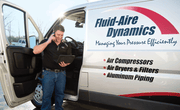Compressed air systems create oily condensate — a mix of water and vaporized compressor lubricants — that must be treated before disposal. Routine compressed air system maintenance includes oil-water separators that remove oil so you can safely drain condensate, stay EPA compliant, and reduce disposal costs.
Why Your Compressor Needs an Oil/Water Separator
According to EPA Title 40 CFR Part 279, water discharged into public systems must contain fewer than 40 parts per million (PPM) of oil. Most untreated condensate from compressed air systems contains over 300 PPM — more than seven times the legal limit. Discharging it untreated risks environmental harm, fines, and equipment issues.
An oil/water separator not only ensures compliance, it also reduces disposal costs, lowers maintenance demands, extends equipment life, and in some cases, allows you to recover usable oil.
To handle condensate responsibly, you have two options:
- Collect and haul: Store condensate in tanks or drums for off-site disposal — costly and labor-intensive.
- Treat on-site: Filter the condensate before discharge. This option is cleaner, compliant, and more economical over time.
In a compressed air system, oily condensate is generated by multiple components, including the compressor, aftercooler, dryer, filters, and receiver tank. An oil/water separator connects to a collection manifold that gathers condensate from all these sources and treats it before the water is safely drained.
How an Oil/Water Separator Works
Modern compressed air systems use multi-stage oil/water separators that combine absorption and adsorption technologies. Here’s a step-by-step breakdown of how they operate:
- Condensate сollection: Moisture and oil vapor from the compressor, dryer, aftercooler, filters, and receiver tank are collected through drain valves and routed into a centralized manifold feeding the oil/water separator.
- Cyclonic depressurization: Condensate enters a chamber where any residual compressed air is vented to the atmosphere. This prevents air pressure from disrupting the filtration stages. To avoid wasting air, zero-loss drain valves are recommended. These open only when liquid is detected, improving system efficiency.
- Polypropylene filter stage: The liquid flows into a filter cartridge made of polypropylene fibers. This non-chemical absorbent material traps the bulk of oil while allowing water to pass through.
- Activated carbon stage: Water continues through a fine-pore activated carbon cartridge, which adsorbs remaining oil molecules to meet EPA limits (typically under 10 PPM).
- Clean water discharge: After treatment, the water exits through a sanitary drain while the oil remains securely captured in the filter media.
Oil/Water Separator Technologies Explained
Modern oil/water separators are engineered to exploit the physical and chemical differences between oil and water. Their effectiveness depends on how well they apply a combination of these core separation mechanisms:
- Gravity separation: Relies on density differences; oil floats to the top while water settles below. This method is simple but limited when dealing with emulsified oil or fine droplets.
- Chemical absorption: Uses reactive filter media that chemically bond with oil while allowing water to pass through unaffected.
- Non-chemical absorption: Employs oleophilic (oil-attracting), hydrophobic (water-repelling) materials like polypropylene to physically draw in oil without chemical reaction.
- Adsorption: Involves trapping oil on the surface of highly porous media such as activated carbon, allowing water to flow through while oil clings to the internal surfaces.
These technologies are often combined within a single system to meet EPA discharge requirements. Their effectiveness is also influenced by basic fluid dynamics: under Stoke’s Law, oil droplets separate more efficiently when they’re larger, the fluid is less turbulent, and the temperature supports stable viscosity.
To apply these technologies in real systems, separators are built in several common configurations — each suited for specific industries and performance needs:
| Separator Type | How It Works | Best For | Limitations |
|---|---|---|---|
| Gravity/API Separator | Uses retention time and baffles to let oil rise and solids settle | Refineries, wastewater pre-treatment, chemical plants | Less effective on emulsified oil or small droplets |
| Coalescing Separator | Media encourages small oil droplets to bind and rise faster | Food production, compressed air systems, workshops | Media maintenance needed; can clog in dirty environments |
| Skimmer-Assisted System | Adds belt or tube skimmers for active surface oil removal | Steel mills, tank washdowns, continuous oil loading | Requires more space and maintenance; higher upfront cost |
How to Install an Oil/Water Separator
Install the oil/water separator in a clean, accessible location — typically in the compressor room. Choose a spot that allows easy access for routine maintenance, including cartridge replacements.
Connect the separator to a condensate manifold that collects discharge from all key system components: compressors, aftercoolers, dryers, filters, and air receiver tanks. Each of these must be equipped with a drain line and properly routed into the manifold for the separator to handle system-wide condensate efficiently.
How to Size the Right Separator
Proper sizing ensures effective oil removal and prevents system overload. Separators are generally sized by the maximum airflow (CFM) of your compressed air system. The greater the CFM, the more condensate is produced, and the more filtration capacity is needed.
PneuTech’s CSO Series includes models rated for 40, 80, 150, 300, 725, and 1250 CFM systems.
Several factors influence sizing:
- Ambient temperature: Colder environments allow filters to hold more oil. Warmer conditions accelerate condensate flow, increasing filter load.
- Operating hours: Most separators are rated for single-shift use. If your facility runs continuously (24/7), filters may need to be changed more frequently.
- Oil concentration and humidity: Heavier oil load or high moisture levels can also reduce filter life and increase maintenance needs.
For facilities operating outside typical temperature ranges (<60°F or >100°F), consider upgrading to a larger unit or adjusting your maintenance schedule accordingly.
Maintaining Your Oil/Water Separator
Routine maintenance is essential for compliance, system longevity, and preventing costly issues downstream. The main task is replacing the internal filter cartridges before they become saturated.
- Weekly to monthly: Collect a water sample from the discharge line and compare it to the included foggy-glass reference. If the sample appears cloudier, it’s time to replace the filter cartridge.
- Monthly to quarterly: Inspect the separation tank for sludge or jelly-like buildup around the filter. Use a suction tool to remove any excess oil or residue before it interferes with performance.
- Quarterly to annually: Replace internal cartridges at least annually, or more often for high-temp or continuous-use systems. Dispose of used filters properly according to local environmental rules.
Keep a maintenance log and follow your manufacturer’s schedule for best results.
Choosing the Right Separator Saves Time and Money
The right oil/water separator won’t just help you meet regulations — it will reduce downtime, simplify maintenance, and lower disposal costs. Draining treated water directly into your sanitary system is far more efficient than collecting and hauling oily waste.
Not sure which separator fits your setup? Fluid-Aire Dynamics can help you select the right model and ensure it's properly sized and installed.
Not Sure Which Oil/Water Separator You Need?
Let our team make it simple — no pressure, just practical help.
Speak to a specialist in Chicago, Minneapolis, Detroit, Philadelphia, or Milwaukee today to be confident in your choice.





